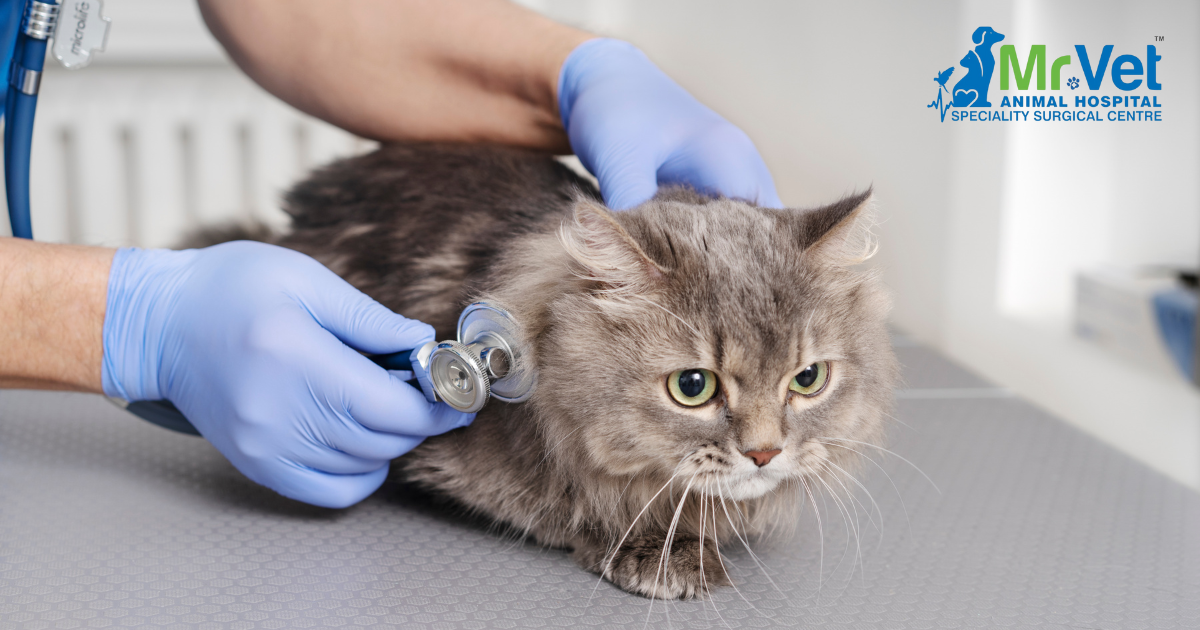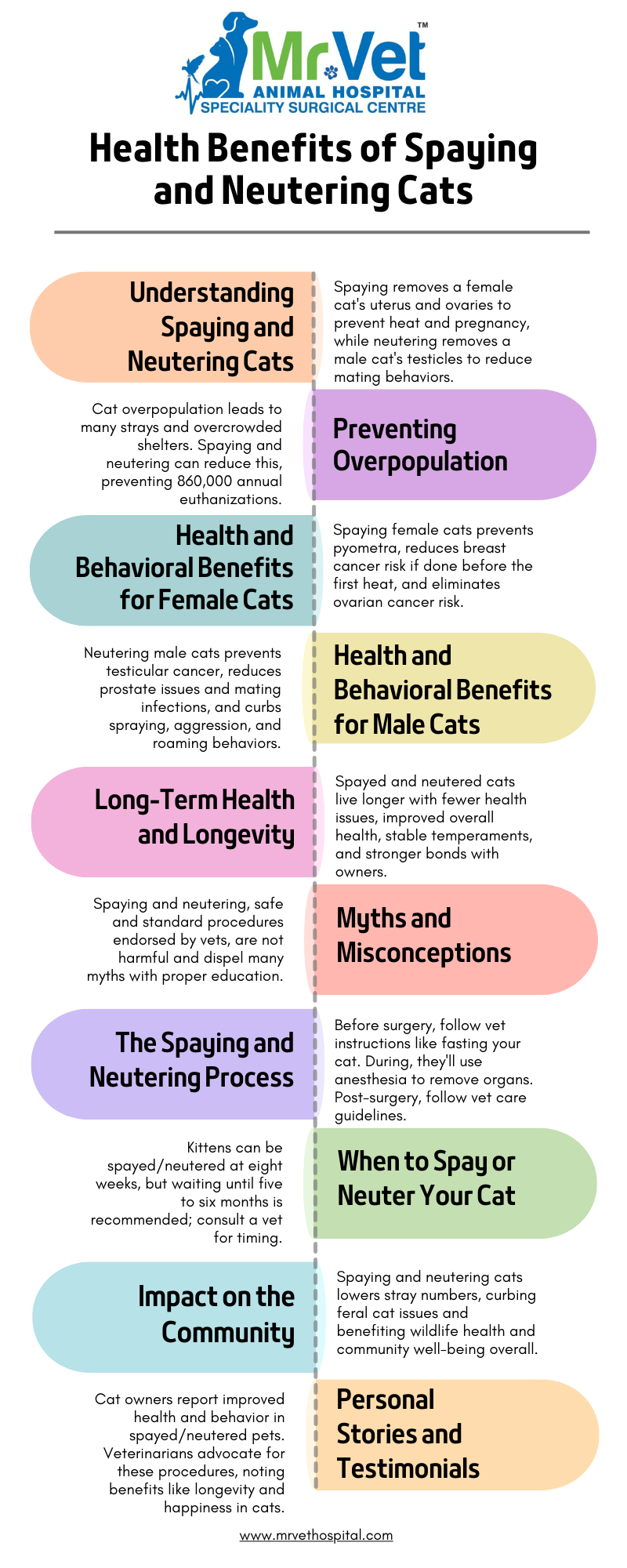Cats are adorable, mischievous, and sometimes aloof creatures that capture our hearts. But as cat owners, we have responsibilities that extend beyond providing food and a cozy bed. One critical aspect of responsible pet ownership is spaying and neutering. Understanding the health benefits of spaying and neutering cats is crucial, not just for your furry friend’s well-being but for the broader community.

Understanding Spaying and Neutering Cats
What is Spaying?
Spaying involves surgically removing the uterus and ovaries from female cats. This process prevents them from going into heat and eliminates the possibility of pregnancy.
What is Neutering?
The surgical excision of a male cat’s testicles is referred to as neutering, or castration. This procedure renders them sterile and reduces behaviors associated with mating instincts.
Differences Between Spaying and Neutering
While both procedures aim to prevent reproduction, spaying pertains to females, and neutering refers to males. Each has unique health and behavioral benefits specific to the cat’s gender.
Preventing Overpopulation
The Problem of Cat Overpopulation
Cat overpopulation is a significant issue, leading to millions of stray and feral cats living in harsh conditions. Overcrowded shelters often have to euthanize cats due to lack of space and resources.
How Spaying and Neutering Help
Spaying and neutering are effective ways to control the cat population. By preventing unwanted litter, we can reduce the number of homeless cats and the strain on animal shelters.
Statistics on Stray and Shelter Cats
Every year, almost 3.2 million cats are brought into American animal shelters, according to the ASPCA. Approximately 860,000 of them are euthanized. Neutering and spaying can drastically lower these numbers.
Health and Behavioral Benefits for Female Cats
Spaying female cats offers significant health benefits by eliminating the risk of pyometra, a severe and potentially life-threatening uterine infection. It also drastically reduces the risk of developing breast cancer, which is often malignant, if done before the first heat cycle. Additionally, spaying removes the ovaries, entirely eliminating the risk of ovarian cancer and contributing to a healthier, longer life for your cat.
Health and Behavioral Benefits for Male Cats
Neutering male cats offers numerous health benefits by removing the testicles, thus eliminating the risk of testicular cancer and significantly reducing the likelihood of prostate problems, including infections and benign prostatic hyperplasia (BPH). It also lowers the risk of infections related to mating behaviors, such as feline immunodeficiency virus (FIV). Additionally, neutering curbs undesirable behaviors like spraying strong-smelling urine to mark territory, reduces aggression and fighting over mates, and diminishes the instinct to roam in search of partners, resulting in a cleaner, safer, and more manageable pet.
Long-Term Health and Longevity
Spayed and neutered cats tend to live longer due to reduced risks of certain cancers and infections. Their overall health often improves as they avoid complications associated with reproduction and hormonal fluctuations. Additionally, with fewer health issues and a more stable temperament, spayed and neutered cats enjoy a higher quality of life, forming stronger bonds with their owners.
Myths and Misconceptions
Common Myths About Spaying and Neutering
There are many myths surrounding spaying and neutering, such as it being unnatural or harmful to the pet’s health.
Debunking These Myths
Spaying and neutering are safe, standard procedures endorsed by veterinarians worldwide. They do not cause harm when performed by a professional.
Providing Factual Information
Educating pet owners with factual information helps dispel fears and misconceptions, encouraging responsible decisions about pet health.
The Spaying and Neutering Process
What to Expect Before the Procedure
Pre-surgery, your vet will provide instructions, such as fasting your cat and ensuring they are in good health for the operation.
During the Procedure
The surgery is performed under general anesthesia, and the vet will make small incisions to remove the reproductive organs.
Post-Surgery Care
After the procedure, your cat will need rest and limited activity. Your vet will provide guidelines for post-operative care to ensure a smooth recovery.
When to Spay or Neuter Your Cat
Kittens can be spayed or neutered as young as eight weeks old, but it is often recommended to wait until they are at least five to six months old. Signs that it’s time for the procedure include the onset of heat cycles in females and territorial behaviors in males, such as spraying or increased aggression. Consulting with a veterinarian is crucial to determine the best timing and approach for spaying or neutering your cat, ensuring the procedure is done safely and at the most appropriate stage of development for optimal health benefits.
Impact on the Community
Spaying and neutering cats significantly impact the community by reducing the number of strays, thereby decreasing the overall cat population and mitigating issues associated with feral communities. This reduction benefits local wildlife by lessening predation, contributing to a balanced ecosystem. Additionally, fewer stray cats lead to improved public health by reducing the spread of zoonotic diseases. These combined effects enhance community well-being and promote a healthier, more harmonious environment for both humans and animals.
Personal Stories and Testimonials
Stories from Cat Owners
Many cat owners share positive experiences, noting improved health and behavior in their spayed or neutered pets.
Testimonials from Veterinarians
Veterinarians consistently advocate for spaying and neutering, citing the numerous health and behavioral benefits they observe in their practice.
Real-Life Benefits Observed
Real-life benefits include longer lifespans, reduced medical issues, and happier, more content cats.
Conclusion
Spaying and neutering cats offer a myriad of benefits, from preventing overpopulation to enhancing individual health and behavior. By making this responsible choice, you not only improve your pet’s quality of life but also contribute positively to your community. Consider consulting with your veterinarian today to discuss spaying or neutering your cat.

